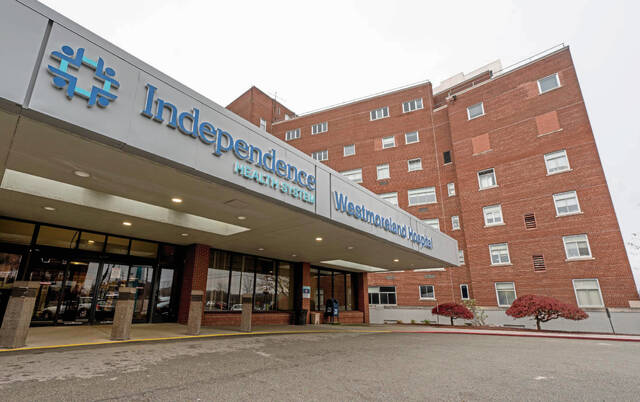Inadequate payment for services nudges small health systems like Independence toward merger, officials say – TribLIVE.com

Analysis of the Independence-WVU Health Merger and its Alignment with Sustainable Development Goals
Executive Summary
A planned merger between Independence Health System and West Virginia University (WVU) Health System highlights a strategic effort to ensure the long-term viability of regional healthcare services, directly addressing key United Nations Sustainable Development Goals (SDGs). The merger is primarily driven by financial pressures on smaller hospital systems, which threaten the provision of accessible and quality healthcare. This report analyzes the merger’s context, objectives, and its alignment with SDG 3 (Good Health and Well-being), SDG 8 (Decent Work and Economic Growth), SDG 9 (Industry, Innovation, and Infrastructure), SDG 10 (Reduced Inequalities), and SDG 17 (Partnerships for the Goals).
Financial Pressures Driving Healthcare Consolidation
The financial instability of regional hospitals is a primary catalyst for the merger, posing a significant risk to community health infrastructure and the achievement of SDG 3.
- Insufficient Reimbursement: Smaller systems like Independence Health lack the negotiating leverage with insurance plans to secure adequate payment for services, a key factor identified by The Center for Healthcare Quality and Payment Reform.
- Operating Losses: Independence Health reported significant financial losses, including approximately $74 million in 2023 and $41 million in fiscal year 2024, underscoring the unsustainable financial model.
- Systemic Underpayment: The Hospital Association of Pennsylvania notes that less than half of the state’s acute care hospitals operate with margins needed for long-term stability. This is exacerbated by programs like Pennsylvania’s Medicaid, which reimburses hospitals at only 71 cents per dollar on average.
Strategic Alignment with SDG 3: Good Health and Well-being
The merger is a direct strategy to fortify healthcare delivery systems, ensuring continued access to quality care for communities served by Independence Health’s five hospitals.
- Ensuring Financial Viability: By joining a larger system, Independence Health aims to achieve financial stability, which is fundamental to maintaining and improving health services and infrastructure.
- Expanding Clinical Services: WVU Health plans to expand specialty and subspecialty services at Westmoreland Hospital and grow clinical services at Butler Memorial Hospital, directly enhancing the quality and scope of available healthcare.
- Strengthening Emergency Care: A key priority includes expanding and upgrading the Butler Memorial Hospital emergency department, a critical component of public health infrastructure.
Economic and Infrastructural Implications (SDG 8 & SDG 9)
The partnership includes a substantial capital commitment that will bolster local economies and modernize healthcare infrastructure, aligning with goals for economic growth and resilient infrastructure.
- Major Capital Investment: WVU Health has committed to an $800 million investment into the Independence Health system. This infusion of capital supports SDG 9 by enabling key upgrades to facilities and technology.
- Infrastructure Modernization: Specific investments include $500 million designated for Westmoreland Hospital and upgrades to other facilities, ensuring they remain modern and effective.
- Supporting Decent Work: While some back-office functions may be consolidated, the stated approach is to keep most resources and personnel hospital-based and close to patients. The financial stabilization of the system is crucial for securing jobs for thousands of healthcare employees, contributing to SDG 8.
Addressing Regional Disparities (SDG 10 & SDG 17)
This cross-state merger represents a partnership (SDG 17) aimed at mitigating the growing inequalities (SDG 10) between large, urban health systems and smaller, regional ones.
- Leveling Negotiating Power: The merger provides Independence Health with the leverage of a larger entity, enabling it to secure more equitable reimbursement contracts and reducing the financial disparity that threatens smaller hospitals.
- Partnership for Sustainability: The collaboration between the Pennsylvania-based Independence Health and the West Virginia-based WVU Health System is a strategic partnership designed to create a more resilient and sustainable regional healthcare network.
- Ensuring Rural and Regional Access: By preventing the potential closure or degradation of services at its five hospitals, the merger ensures that communities in Butler, Clarion, Greensburg, Latrobe, and Mt. Pleasant maintain access to comprehensive healthcare, combating the rise of healthcare deserts.
1. SDGs Addressed in the Article
-
SDG 3: Good Health and Well-being
This goal is central to the article, which discusses the financial stability of hospitals, access to healthcare services, and investments in medical facilities. The merger is presented as a strategy to ensure that five hospitals in Butler, Clarion, Greensburg, Latrobe, and Mt. Pleasant can continue to provide care amidst financial losses and insufficient reimbursement. The article highlights that “less than half of the state’s acute care hospitals are operating with margins needed for long-term stability,” directly threatening the provision of healthcare.
-
SDG 8: Decent Work and Economic Growth
The article touches upon the economic viability of the healthcare sector and its role as an employer. The financial distress of Independence Health, which posted losses of “$74 million in 2023,” jeopardizes the organization’s sustainability and the jobs it provides. The merger’s impact on employees is also discussed, with WVU Health stating they “consolidate certain back-office functions when it makes sense,” such as legal, human resources, and IT, which relates to employment and economic efficiency.
-
SDG 10: Reduced Inequalities
The article highlights inequalities within the healthcare financing system. It points out that a “key driver of this stress is that payments do not cover the cost of providing care.” Specifically, it mentions that “Pennsylvania’s Medicaid program…has chronically underpaid hospitals, reimbursing only 71 cents per dollar, on average.” This disparity in reimbursement for services provided to vulnerable populations creates financial inequality among healthcare providers, disproportionately affecting those serving a higher number of Medicaid patients.
-
SDG 17: Partnerships for the Goals
The entire article is about a partnership—the merger between Independence Health and West Virginia University Health System. This partnership is a strategic response to systemic economic challenges in the healthcare sector. It aims to leverage the size and negotiating power of a larger system to ensure the survival and enhancement of smaller, regional hospitals, demonstrating a private-sector partnership to achieve the goal of sustainable healthcare delivery.
2. Specific Targets Identified
-
Target 3.8: Achieve universal health coverage, including financial risk protection, access to quality essential health-care services and access to safe, effective, quality and affordable essential medicines and vaccines for all.
The article connects to this target by discussing the threat to healthcare access posed by hospital financial instability. A consultant is quoted saying, “A lot of the smaller hospitals are closing because they aren’t getting adequate payment.” The merger aims to prevent this, thereby preserving access to essential healthcare services for the communities served by Independence Health’s five hospitals.
-
Target 3.c: Substantially increase health financing and the recruitment, development, training and retention of the health workforce.
This target is addressed through the issue of inadequate health financing and the proposed solution. The article details how insufficient payments from insurers and Medicaid threaten hospitals. The merger directly addresses this by bringing in a major financial commitment, with WVU Health promising to “invest $800 million into Independence Health, including $500 million at Westmoreland Hospital.” This is a direct increase in health financing aimed at upgrading facilities and expanding services.
-
Target 8.5: By 2030, achieve full and productive employment and decent work for all women and men… and equal pay for work of equal value.
The merger’s impact on the workforce is discussed, linking to this target. While the primary goal is financial stability for the system, the article notes the potential for job consolidation in “back-office functions” like “legal, human resources, corporate compliance, information technology and select elements of finance.” This shows a consideration of employment structures and efficiency as part of the economic strategy.
-
Target 10.4: Adopt policies, especially fiscal, wage and social protection policies, and progressively achieve greater equality.
The article points to a fiscal policy issue that creates inequality: the underpayment by Pennsylvania’s Medicaid program. The statement that the program reimburses “only 71 cents per dollar” highlights a policy that contributes to the financial instability of hospitals, particularly those serving lower-income populations, thus linking directly to the need for more equitable fiscal policies in healthcare.
-
Target 17.17: Encourage and promote effective public, public-private and civil society partnerships, building on the experience and resourcing strategies of partnerships.
The merger between WVU Health System and Independence Health is a direct example of a private-private partnership aimed at achieving a sustainable outcome. The article explains the rationale for this partnership: smaller systems lack the “negotiating leverage” with insurers, and merging with a larger system provides financial stability and resources. This demonstrates a strategic partnership to overcome systemic challenges.
3. Indicators for Measuring Progress
-
Financial Stability of Hospitals (Implied)
The article provides several data points that can be used as indicators of financial health. It states that “less than half of the state’s acute care hospitals are operating with margins needed for long-term stability” and “More than one-third of the hospitals have experienced multiyear losses.” The specific losses of Independence Health (“$74 million in 2023”) also serve as a direct indicator.
-
Investment in Health Infrastructure (Mentioned)
A clear, quantifiable indicator is mentioned in the article: the promised investment of “$800 million into Independence Health” by WVU Health. This includes a specific allocation of “$500 million at Westmoreland Hospital” and plans to upgrade the “Butler Memorial Hospital emergency department.”
-
Public Health Financing Rates (Mentioned)
The article provides a specific indicator for the adequacy of public health financing by stating that Pennsylvania’s Medicaid program reimburses hospitals at a rate of “71 cents per dollar, on average.” This metric can be used to track progress towards more equitable payment policies.
-
Hospital Closures (Implied)
The statement that “A lot of the smaller hospitals are closing because they aren’t getting adequate payment” implies that the number of hospital closures is a key indicator of the health system’s stability and its ability to provide access to care.
-
Employment Consolidation (Implied)
The article implies an indicator for employment impact by mentioning the consolidation of “certain back-office functions.” Tracking the number of positions affected in departments like “legal, human resources, corporate compliance, information technology and select elements of finance” would measure the merger’s effect on employment.
4. Table of SDGs, Targets, and Indicators
| SDGs | Targets | Indicators |
|---|---|---|
| SDG 3: Good Health and Well-being |
|
|
| SDG 8: Decent Work and Economic Growth |
|
|
| SDG 10: Reduced Inequalities |
|
|
| SDG 17: Partnerships for the Goals |
|
|
Source: triblive.com
What is Your Reaction?
 Like
0
Like
0
 Dislike
0
Dislike
0
 Love
0
Love
0
 Funny
0
Funny
0
 Angry
0
Angry
0
 Sad
0
Sad
0
 Wow
0
Wow
0



















































.jpg.webp?itok=0ZsAnae9#)























